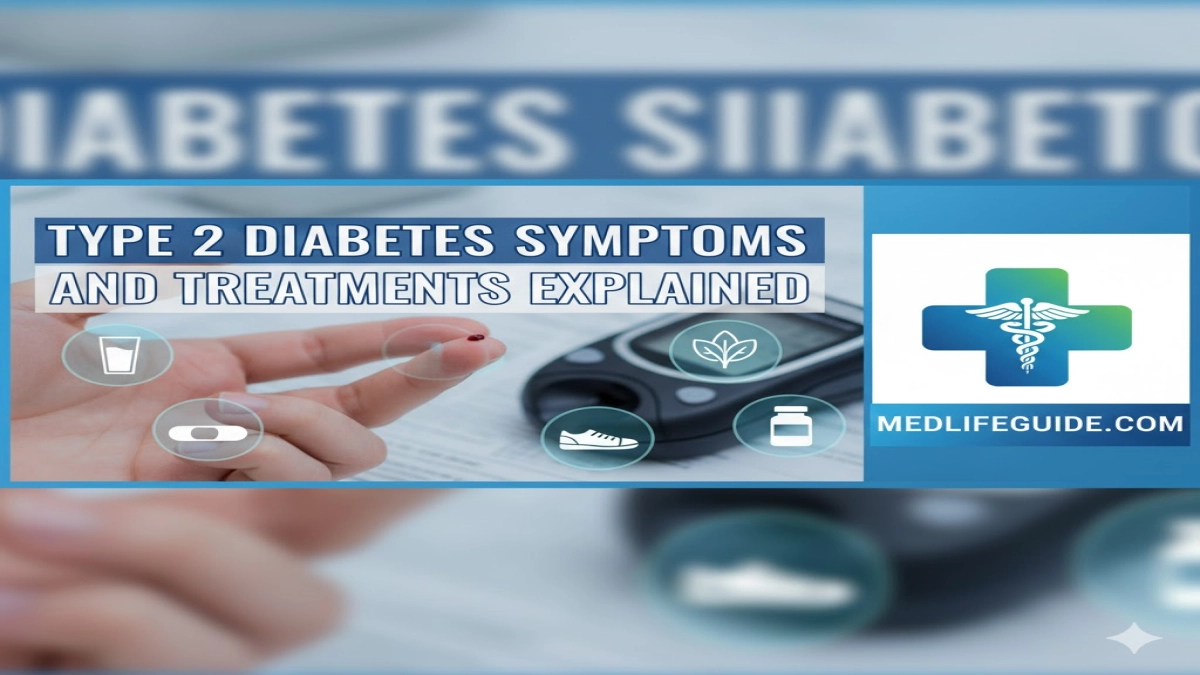Medically Reviewed and Compiled by Dr. [Adam N. Khan], MD.
Type 2 diabetes is a chronic metabolic condition where the body can’t use insulin properly (insulin resistance) and/or doesn’t make enough insulin. That results in high blood sugar over time, which damages nerves, blood vessels, kidneys, eyes, and more. This article explains symptoms, how clinicians diagnose it, treatment options (from lifestyle to medications and surgery), monitoring goals, and a dedicated section of clinical takeaways you won’t find in every patient handout. Key claims below are supported by major medical sources.
Quick summary (read first)
- Early or mild type 2 diabetes often causes no symptoms — screening is essential if you have risk factors.
- Common symptoms: frequent urination, excessive thirst, fatigue, blurred vision, slow-healing wounds, numbness/tingling in feet.
- First-line treatment is focused lifestyle change (weight loss, diet, exercise). Metformin is usually the initial medication if drugs are needed. Newer drug classes (GLP-1 receptor agonists, SGLT2 inhibitors) also lower blood sugar and provide weight and cardiovascular benefits.
How people usually present (Symptoms)
Typical symptoms
- Going to the bathroom more often (especially at night) and being unusually thirsty.
- Feeling very tired and weak without explanation.
- Blurred vision and slow healing of cuts or infections.
- Numbness, tingling, or burning in the feet (early neuropathy).
When symptoms are absent
Many people have mild or no symptoms for years. That’s why targeted screening for people with risk factors (overweight, family history, certain ethnicities, age) is crucial.
Red flags — call a clinician now
- Sudden confusion, very high blood sugars with dehydration, rapid breathing, or vomiting — these can signal hyperosmolar hyperglycemic state (an emergency).
Diagnosis — what clinicians look for
Lab tests
- Fasting plasma glucose ≥126 mg/dL (7.0 mmol/L), or
- A1c ≥6.5%, or
- 2-hour plasma glucose ≥200 mg/dL after a 75 g oral glucose tolerance test, or
- A random plasma glucose ≥200 mg/dL with classic symptoms.
Diagnosis should be confirmed by repeat testing unless clinical presentation is obvious.
Workup and baseline measurements
At diagnosis clinicians typically check: A1c, fasting lipids, kidney function (eGFR, urine albumin-creatinine ratio), liver tests, blood pressure, BMI, and foot and eye baseline exams. These guide risk stratification and treatment choices.
Treatment overview — practical, stepwise plan
Treatment has three simultaneous aims: lower blood glucose to safe targets, reduce short- and long-term complications (heart, kidney, eye disease), and improve quality of life.
Foundational care (every patient)
- Lifestyle first — reduce excess weight, follow a structured eating plan, increase physical activity, stop smoking, and limit alcohol. Even 5–10% weight loss improves glucose control.
- Education and team care — diabetes self-management education, nutrition counseling, and behavioral support.
Medications — common classes and what they do
- Metformin — usual first-line drug unless contraindicated (renal impairment, intolerance). Low cost, modest weight neutrality, lowers A1c by ~1%.
- SGLT2 inhibitors (e.g., empagliflozin, canagliflozin) — lower glucose, reduce heart failure and CKD progression in many patients. Consider in those with cardiovascular or kidney disease.
- GLP-1 receptor agonists (e.g., semaglutide, liraglutide) — reduce A1c and body weight and have cardiovascular benefits for many patients; injectable (some now oral).
- DPP-4 inhibitors, sulfonylureas, thiazolidinediones — options with varying effects on weight, side effects, and cost. Choice is individualized.
- Insulin — used when A1c is very high at presentation or when oral/injectable non-insulin therapies are insufficient. Modern basal/bolus regimens or simplified basal-only plans are common.
Advanced/specialty options
- Bariatric/metabolic surgery — for those meeting BMI and comorbidity criteria, surgery can dramatically improve glucose control and sometimes induce remission.
- Remission programs (very low-calorie diets) — structured low-calorie interventions have produced remission in selected patients with recent-onset disease; programs are increasingly available in public health systems. Outcomes depend on weight loss magnitude and duration of diabetes.
Monitoring goals and follow-up
- A1c target: commonly <7% for many nonpregnant adults; individualized based on age, comorbidities, and hypoglycemia risk.
- Self-monitoring: frequency depends on therapy (insulin users test more). Continuous glucose monitoring is increasingly used.
- Other targets: BP <130/80–140/90 (individualized), LDL management per cardiovascular risk, smoking cessation, annual eye and foot checks, and kidney monitoring every 1–2 years or sooner if abnormal.
Complications to watch for (short and long term)
- Microvascular: neuropathy (feet), nephropathy (CKD), retinopathy (vision loss).
- Macrovascular: heart attack, stroke, peripheral arterial disease. Some glucose-lowering drugs reduce these risks beyond their sugar-lowering effects.
Unique Clinical Takeaways
These are practical, clinician-minded insights drawn from clinical evidence and patient experience — useful for tailoring care.
1) The “silent” cardiorespiratory signal — fType 2 Diabetes Symptoms and Treatments Guideatigue, fitness drop, and early risk
Patients often report reduced exercise tolerance or persistent fatigue before classic hyperglycemic symptoms appear. That drop in functional capacity is an early, patient-centered marker of metabolic stress linked to insulin resistance and cardiovascular risk. Track simple functional metrics (6-minute walk, ability to climb stairs) over time — they can prompt earlier testing and motivate lifestyle change more effectively than weight or glucose numbers alone. Evidence linking early fitness decline to worse outcomes supports earlier intervention.
2) Differential diagnosis matters — don’t assume type 2 in every adult
Adults with new hyperglycemia may actually have: LADA (latent autoimmune diabetes of adulthood), MODY (monogenic forms), drug-induced hyperglycemia (steroids, antipsychotics), or secondary diabetes from pancreatic disease. If BMI is low, progression is rapid, or there’s a strong autoimmune pattern or family history of early-onset diabetes, pursue antibody testing or genetic referral. Mislabeling leads to suboptimal treatment (for example, delayed insulin for LADA).
3) Weight-loss trajectory predicts treatment durability
How a patient loses weight — rapid vs steady, program adherence, and regain pattern — predicts whether remission is likely and how durable it will be. Structured programs combining behavior, dietary structure, and pharmacotherapy or surgery produce better long-term maintenance than ad-hoc dieting. Clinicians should set expectations: remission is possible, but ongoing weight maintenance strategies (not just initial weight loss) determine long-term success. Recent public-health programs and trials show up to ~40–50% remission in carefully selected, early-diagnosis patients with intensive weight loss.
4) Kidney-first thinking for drug choice
For patients with albuminuria or reduced eGFR, choose agents with kidney-protective data (certain SGLT2 inhibitors) early — not as an afterthought. This approach reduces progression to dialysis and should shape first-line add-on choices beyond pure A1c lowering. Screening urine albumin at baseline is therefore high-value.
Practical patient-facing action plan (what to do now)
- If you have risk factors (overweight, family history, high BP, certain ethnic backgrounds), ask your clinician for a screening A1c or fasting glucose.
- Start with realistic lifestyle steps: aim for 150 minutes/week of moderate activity and a structured nutrition plan that reduces calories but is sustainable. Even 5% weight loss matters.
- If diagnosed, get baseline labs (A1c, lipids, kidney tests) and schedule eye and foot checks.
- Discuss medication options, especially if you have heart or kidney disease — newer drug classes add cardiovascular and renal protection beyond glucose lowering.
References and Citations
All sources below were used to compile clinical statements in this article:
- American Diabetes Association — Understanding Type 2 Diabetes. American Diabetes Association
- Centers for Disease Control and Prevention (CDC) — About Type 2 Diabetes; Managing Blood Sugar. CDC+1
- NHS (UK) — Type 2 diabetes: symptoms and treatment. NHS+1
- Mayo Clinic — Type 2 diabetes: Symptoms, diagnosis & treatment. Mayo Clinic+1
- StatPearls / NCBI Bookshelf — Type 2 Diabetes (overview of pathophysiology). NCBI
- NHS coverage/news on low-calorie remission programs and scaling of remission pathways. The Sun
Medical disclaimer
This article is for informational purposes only and does not replace medical advice. Diagnosis and treatment must be individualized. Always consult a licensed healthcare professional before starting or changing medical treatment.

